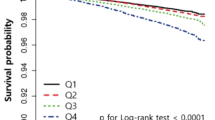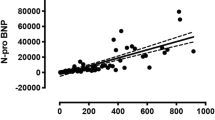Abstract
Background
The levels of many laboratory parameters are associated with the outcomes of dialysis patients, but the significance of their variability has not been well studied.
Methods
A total of 384 patients receiving stable hemodialysis treatment during 2002 were followed up for mortality until the end of 2013. The within-patient coefficients of variation (CV) were calculated for 13 laboratory parameters from 1 year of data. We defined variability as CV and analyzed the survival of the patients according to the baseline CV values of each parameter by proportional hazard modeling.
Results
During the 11-year observation period, 125 patients died. Higher CV levels for eight parameters, namely, blood urea nitrogen (BUN), sodium, hemoglobin, creatinine, total protein, albumin, potassium and phosphate, were significantly associated with all-cause mortality. The adjusted hazard ratios for a high BUN-CV (>15 %) and a high Na-CV (>1.3 %) against a lower CV were 1.92 (95 % CI 1.31–2.81) and 1.95 (1.36–2.80), respectively. The increased mortality risk associated with each variability was attributed to excess non-cardiac deaths. The CV values of most parameters were correlated with each other and often exhibited negative associations with age, diabetes, and mobility as well as the levels of hemoglobin, albumin, creatinine, Na, the protein catabolic rate, and the creatinine generation rate. Therefore, a high variability was generally associated with frailty-related adverse prognostic factors.
Conclusions
The variability of several blood parameters had a significant impact on all-cause and non-cardiac mortality. The levels of the variabilities were most likely related to poor physical conditions of the patients.





Similar content being viewed by others
References
Desai AA, Nissenson A, Chertow GM, et al. The relationship between laboratory-based outcome measures and mortality in end-stage renal disease: a systematic review. Hemodial Int. 2009;13:347–59.
Kovesdy CP, Kalantar-Zadeh K. Review article: biomarkers of clinical outcomes in advanced chronic kidney disease. Nephrology (Carlton). 2009;14:408–15.
Shinzato T, Nakai S, Miwa M, et al. New method to calculate creatinine generation rate using pre- and postdialysis creatinine concentrations. Artif Organs. 1997;21:864–72.
Scrucca L, Santucci A, Aversa F. Competing risk analysis using R: an easy guide for clinicians. Bone Marrow Transplant. 2007;40:381–7.
Moreau-Gaudry X, Jean G, Genet L, et al. A simple protein-energy wasting score predicts survival in maintenance hemodialysis patients. J Ren Nutr. 2014;24:395–400.
Burrowes JD, Cockram DB, Dwyer JT, et al. Cross-sectional relationship between dietary protein and energy intake, nutritional status, functional status, and comorbidity in older versus younger hemodialysis patients. J Ren Nutr. 2002;12:87–95.
Desmeules S, Lévesque R, Jaussent I, et al. Creatinine index and lean body mass are excellent predictors of long-term survival in haemodiafiltration patients. Nephrol Dial Transplant. 2004;19:1182–9.
Qureshi AR, Alvestrand A, Danielsson A, et al. Factors predicting malnutrition in hemodialysis patients: a cross-sectional study. Kidney Int. 1998;53:773–82.
Chmielewski M, Verduijn M, Drechsler C, et al. Low cholesterol in dialysis patients–causal factor for mortality or an effect of confounding? Nephrol Dial Transplant. 2011;26:3325–31.
Terrier N, Jaussent I, Dupuy A-M, et al. Creatinine index and transthyretin as additive predictors of mortality in haemodialysis patients. Nephrol Dial Transplant. 2008;23:345–53.
Hermans MMH, Brandenburg V, Ketteler M, et al. Association of serum fetuin-A levels with mortality in dialysis patients. Kidney Int. 2007;72:202–7.
Van Dijk S, van den Beukel TO, Kaptein AA, et al. How baseline, new-onset, and persistent depressive symptoms are associated with cardiovascular and non-cardiovascular mortality in incident patients on chronic dialysis. J Psychosom Res. 2013;74:511–7.
Keshaviah PR, Nolph KD, Moore HL, et al. Lean body mass estimation by creatinine kinetics. J Am Soc Nephrol. 1994;4:1475–85.
Merlot AM, Kalinowski DS, Richardson DR. Unraveling the mysteries of serum albumin-more than just a serum protein. Front Physiol. 2014;5:299.
Ebah LM, Wiig H, Dawidowska I, et al. Subcutaneous interstitial pressure and volume characteristics in renal impairment associated with edema. Kidney Int. 2013;84:980–8.
Wiig H, Schröder A, Neuhofer W, et al. Immune cells control skin lymphatic electrolyte homeostasis and blood pressure. J Clin Invest. 2013;123:2803–15.
Dahlmann A, Dörfelt K, Eicher F, et al. Magnetic resonance-determined sodium removal from tissue stores in hemodialysis patients. Kidney Int. 2014;87(2):434–41.
Canaud B, Tong L, Tentori F, et al. Clinical practices and outcomes in elderly hemodialysis patients: results from the Dialysis Outcomes and Practice Patterns Study (DOPPS). Clin J Am Soc Nephrol. 2011;6:1651–62.
Conflict of interest
All the authors have declared no competing interest.
Author information
Authors and Affiliations
Corresponding author
About this article
Cite this article
Nakazato, Y., Kurane, R., Hirose, S. et al. Variability of laboratory parameters is associated with frailty markers and predicts non-cardiac mortality in hemodialysis patients. Clin Exp Nephrol 19, 1165–1178 (2015). https://doi.org/10.1007/s10157-015-1108-0
Received:
Accepted:
Published:
Issue Date:
DOI: https://doi.org/10.1007/s10157-015-1108-0




